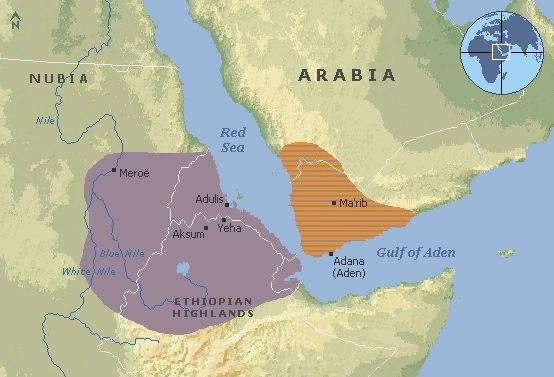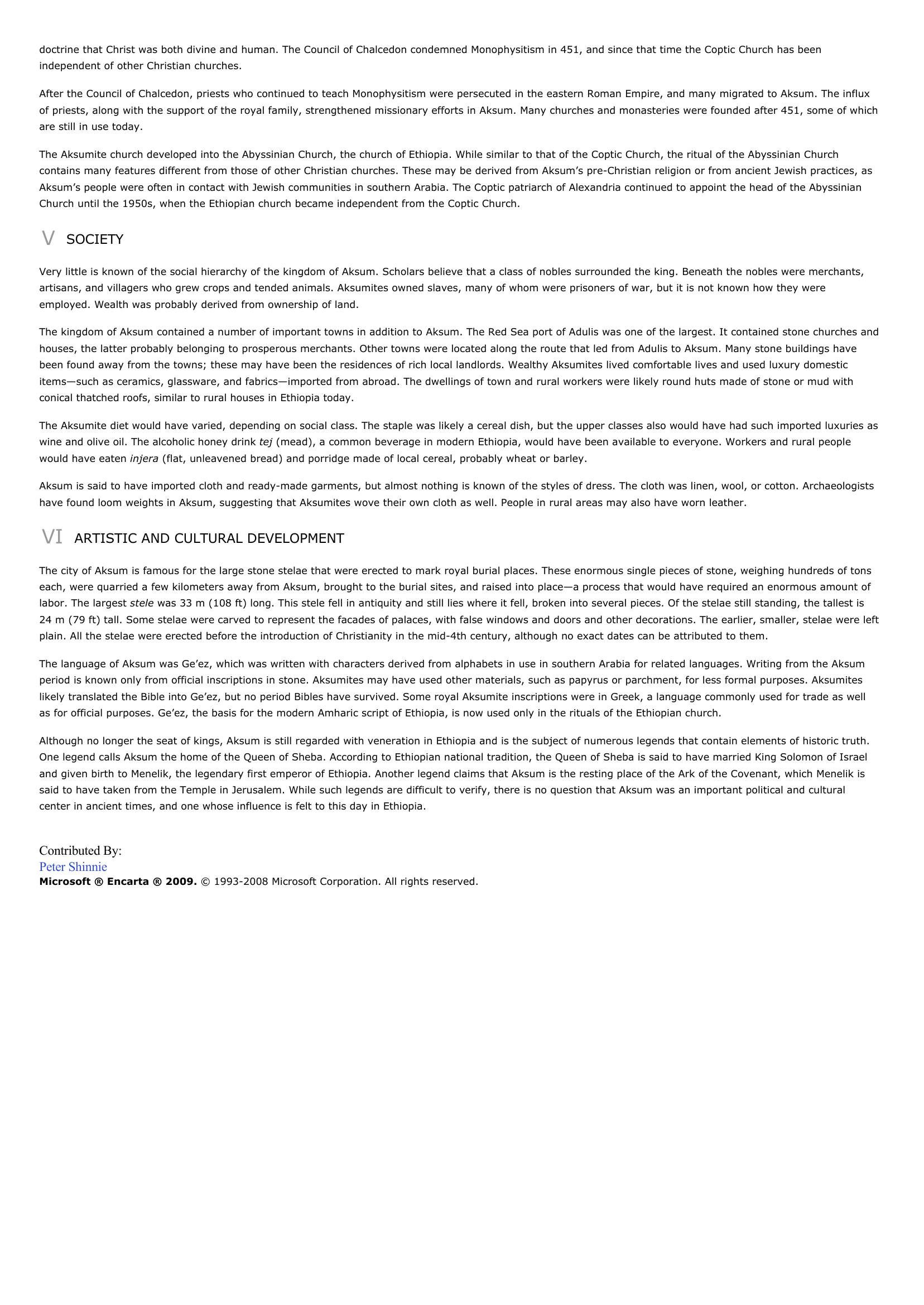Aksum.
Publié le 01/05/2013

Extrait du document


«
doctrine that Christ was both divine and human.
The Council of Chalcedon condemned Monophysitism in 451, and since that time the Coptic Church has beenindependent of other Christian churches.
After the Council of Chalcedon, priests who continued to teach Monophysitism were persecuted in the eastern Roman Empire, and many migrated to Aksum.
The influxof priests, along with the support of the royal family, strengthened missionary efforts in Aksum.
Many churches and monasteries were founded after 451, some of whichare still in use today.
The Aksumite church developed into the Abyssinian Church, the church of Ethiopia.
While similar to that of the Coptic Church, the ritual of the Abyssinian Churchcontains many features different from those of other Christian churches.
These may be derived from Aksum’s pre-Christian religion or from ancient Jewish practices, asAksum’s people were often in contact with Jewish communities in southern Arabia.
The Coptic patriarch of Alexandria continued to appoint the head of the AbyssinianChurch until the 1950s, when the Ethiopian church became independent from the Coptic Church.
V SOCIETY
Very little is known of the social hierarchy of the kingdom of Aksum.
Scholars believe that a class of nobles surrounded the king.
Beneath the nobles were merchants,artisans, and villagers who grew crops and tended animals.
Aksumites owned slaves, many of whom were prisoners of war, but it is not known how they wereemployed.
Wealth was probably derived from ownership of land.
The kingdom of Aksum contained a number of important towns in addition to Aksum.
The Red Sea port of Adulis was one of the largest.
It contained stone churches andhouses, the latter probably belonging to prosperous merchants.
Other towns were located along the route that led from Adulis to Aksum.
Many stone buildings havebeen found away from the towns; these may have been the residences of rich local landlords.
Wealthy Aksumites lived comfortable lives and used luxury domesticitems—such as ceramics, glassware, and fabrics—imported from abroad.
The dwellings of town and rural workers were likely round huts made of stone or mud withconical thatched roofs, similar to rural houses in Ethiopia today.
The Aksumite diet would have varied, depending on social class.
The staple was likely a cereal dish, but the upper classes also would have had such imported luxuries aswine and olive oil.
The alcoholic honey drink tej (mead), a common beverage in modern Ethiopia, would have been available to everyone.
Workers and rural people would have eaten injera (flat, unleavened bread) and porridge made of local cereal, probably wheat or barley.
Aksum is said to have imported cloth and ready-made garments, but almost nothing is known of the styles of dress.
The cloth was linen, wool, or cotton.
Archaeologistshave found loom weights in Aksum, suggesting that Aksumites wove their own cloth as well.
People in rural areas may also have worn leather.
VI ARTISTIC AND CULTURAL DEVELOPMENT
The city of Aksum is famous for the large stone stelae that were erected to mark royal burial places.
These enormous single pieces of stone, weighing hundreds of tonseach, were quarried a few kilometers away from Aksum, brought to the burial sites, and raised into place—a process that would have required an enormous amount oflabor.
The largest stele was 33 m (108 ft) long.
This stele fell in antiquity and still lies where it fell, broken into several pieces.
Of the stelae still standing, the tallest is 24 m (79 ft) tall.
Some stelae were carved to represent the facades of palaces, with false windows and doors and other decorations.
The earlier, smaller, stelae were leftplain.
All the stelae were erected before the introduction of Christianity in the mid-4th century, although no exact dates can be attributed to them.
The language of Aksum was Ge’ez, which was written with characters derived from alphabets in use in southern Arabia for related languages.
Writing from the Aksumperiod is known only from official inscriptions in stone.
Aksumites may have used other materials, such as papyrus or parchment, for less formal purposes.
Aksumiteslikely translated the Bible into Ge’ez, but no period Bibles have survived.
Some royal Aksumite inscriptions were in Greek, a language commonly used for trade as wellas for official purposes.
Ge’ez, the basis for the modern Amharic script of Ethiopia, is now used only in the rituals of the Ethiopian church.
Although no longer the seat of kings, Aksum is still regarded with veneration in Ethiopia and is the subject of numerous legends that contain elements of historic truth.One legend calls Aksum the home of the Queen of Sheba.
According to Ethiopian national tradition, the Queen of Sheba is said to have married King Solomon of Israeland given birth to Menelik, the legendary first emperor of Ethiopia.
Another legend claims that Aksum is the resting place of the Ark of the Covenant, which Menelik issaid to have taken from the Temple in Jerusalem.
While such legends are difficult to verify, there is no question that Aksum was an important political and culturalcenter in ancient times, and one whose influence is felt to this day in Ethiopia.
Contributed By:Peter ShinnieMicrosoft ® Encarta ® 2009. © 1993-2008 Microsoft Corporation.
All rights reserved..
»
↓↓↓ APERÇU DU DOCUMENT ↓↓↓


